Home | Tours | Trip Reports | News | Team | Calendar | Links | Contact | Store | Mailing List
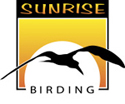
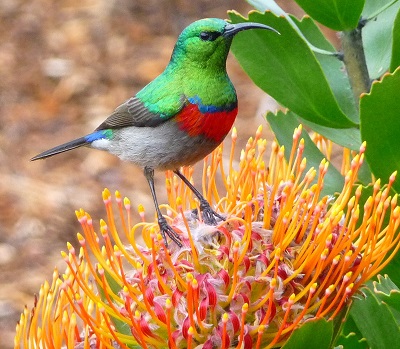 SOUTH AFRICA
SOUTH AFRICA The Cape, The Garden Route
& Kruger National Park
October 27 - November 11, 2025
Contact [email protected] to reserve!
Trip
Cost & Travel
Planning> Registration
Form>
Tour
Registration, Terms,
Cancellation Policies>
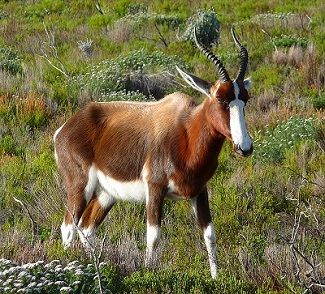 The southern tip of Africa is one of the greatest biodiversity hotspots in the world attracting birders, botanists, and mammal enthusiasts from around the globe. Offering a multitude of endemic birds, the classic African mammals, and a rich and unique botanical heritage, the multi-ethnic nation of South Africa stands out as a bucket list destination. This tour South Africa's sought after wildlife and regional specialties of the Cape Peninsula, the Garden Route, and the famed Kruger National Park.
The southern tip of Africa is one of the greatest biodiversity hotspots in the world attracting birders, botanists, and mammal enthusiasts from around the globe. Offering a multitude of endemic birds, the classic African mammals, and a rich and unique botanical heritage, the multi-ethnic nation of South Africa stands out as a bucket list destination. This tour South Africa's sought after wildlife and regional specialties of the Cape Peninsula, the Garden Route, and the famed Kruger National Park.
We begin our tour in Cape Town where we embark on a pelagic trip into the South Atlantic, an area famous among birders the world over for offering some of the largest concentrations of seabirds anywhere on the planet. We could see up to seven species of 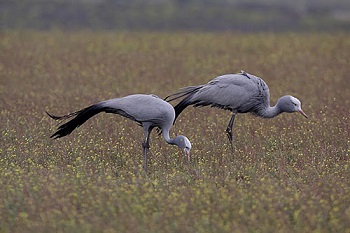 albatross, as well as countless shearwaters, skuas, petrels, and prions.
albatross, as well as countless shearwaters, skuas, petrels, and prions.
From here we explore the Cape Peninsula, often called the "Jewel of South Africa", traversing the spectacular, rugged scenery that is home to penguins, ostriches, several species of antelope, and the unique "fynbos" vegetation.
Then we move to the lush forested coastal region known as the Garden Route, a mosaic of coastlines, wetlands and forests. The Garden Route offers its own specialties like the Forest Buzzard, Black Sparrowhawk, Knysna Woodpecker, Knysna Warbler, Grey Cuckooshrike ,and Narina Trogon – and the showy Knysna Turaco!
To cap it off, we fly north to the interior of the country, where we embark on a birding safari in the world renowned Kruger National Park, one of the largest game reserves in Africa and is home to lions, leopards, elephants, and giraffes and more than 500 species of birds!
Join Gina Nichol and Steve Bird to experience the birds, animals, and stunning landscapes of South Africa.
Add good food, lovely accommodations, great wine from the Cape winelands, and impressive African mammals, and you are in for the trip of a lifetime!
Photos above: Southern Double-collared Sunbird by Gina Nichol; Bontebok by Steve Bird; Blue Cranes by Steve Hinton; Giraffes in Kruger National Park by Gina Nichol.
Trip Cost & Travel Planning> Registration Form> Tour Registration, Terms, Cancellation Policies>
ITINERARY --
This tour begins in Cape Town, South Africa and ends in Johannesburg.
Day 1: Arrival Cape Town
Plan to arrive today at Cape Town International Airport on South Africa’s southwest coast (Airport code: CPT). You'll be transferred to our lovely guest house where you can settle in. Plan to meet for an introductory dinner with the your guides. There are no activities planned for today. The main birding that starts tomorrow. Night: Cape Town.
Note that the itinerary of the first few days is weather dependent and based on the best conditions for the pelagic trip.
Day 2: Cape Peninsula - Kirstenbosch Gardens, Strandfontein Wetland Reserve
This day tour takes us to the world famous Kirstenbosch Botanical Garden, where we can enjoy the large variety of birds that it attracts. Birds make good use of the verdant flowers in the Gardens and we hope for point blank views of two of the Cape’s endemic species: the Cape Sugarbird and the Orange-breasted Sunbird as well as a chance to see the roosting Spotted Eagle-Owls. Other species here include Southern Double-collared Sunbird, Malachite Sunbird, Swee Waxbill, Cape Robin-chat, Cape Francolin, Helmeted Guineafowl, Karoo Prinia, Southern Boubou, Red-chested Cuckoo, Black Saw-wing Swallow, Speckled Mousebird, and more.
We'll also visit Strandfontein Wetland Reserve, a RAMSAR site encompassing more than 750 acres and also known as the Cape Flats Waste Water Treatment Works, a premier birding spot close Cape Town. The large pans of Strandfontein Wetland Reserve allow us to explore the wonderful array of wetland and coastal shrub habitat containing a host of different species, such as Great White Pelican, Greater Flamingo, Cape Teal, African Marsh Harrier, and Maccoa Duck. Other possibilities here include Blacksmith Lapwing (Plover), Black-headed Heron, Cape Canary, Burchell’s (White-browed) Coucal (nE), Cape Shoveler (nE), Blue-billed Teal, and Yellow-billed Duck. Rarer species can occur here such as South African Shelduck (nE), White-faced and Fulvous Whistling Ducks and White-backed Duck. Night: Cape Town.
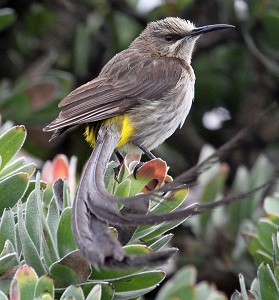
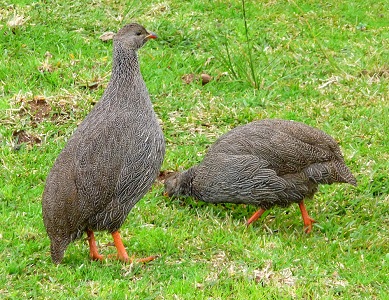
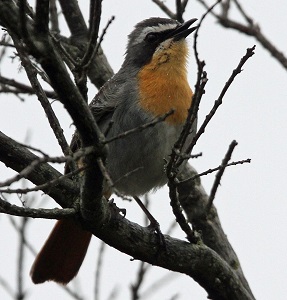
Photos: View from Kirstenbosch Garden, Gina Nichol; Cape Sugarbird by Steve Bird; Cape Spurfowl by Gina Nichol; Cape Robin-chat by Steve Bird.
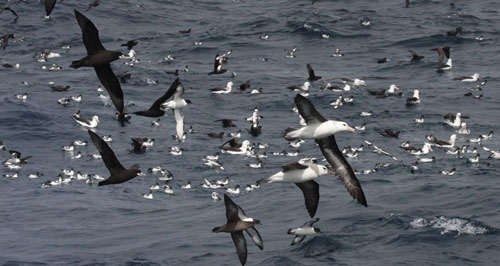 Day 3: Pelagic (weather-dependent)
Day 3: Pelagic (weather-dependent)
An early start takes us to Simonstown where we board a boat and head off the southern tip of Africa and into the cold Benguela current system. Here we search for deep sea trawlers and the pelagic bird species which often accompany them. Even if we don’t find a trawler, the concentrations and closeness of birds is impressive. This trip takes in the coastal areas as well as deep water off the continental shelf. Key species for the day are: Shy, Black-browed and a chance for both species of Yellow-nosed Albatross, not to mention several species of shearwaters, petrels and storm-petrels. We will also target all seven species of coastal bird species endemic to the Benguela current system. Night: Cape Town.
Photo: Seabirds off Cape Town
Day 4: West Coast National Park
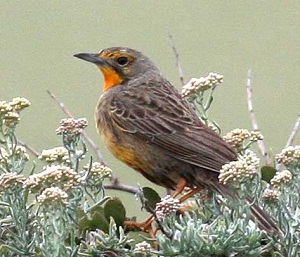 Today we take a day trip up the West Coast, known for its quaint seaside towns and spectacular flower displays. Among the birding community, it is a haven for birds of the strandveld as well as one of the best areas to find large numbers of migratory waders around the large Langebaan Lagoon. This day will explore the rich habitat of the West Coast National Park as well as some inland farms to seek out a wide variety of bird species. These include the endangered and endemic Black Harrier and the unobtrusive Southern Black Korhaan. Other specials should include Grey-winged Francolin, Grey Tit, Cape Penduline Tit, White-backed Mousebird, Karoo Scrub-robin Chestnut-vented Warbler, Cape Large-billed Lark and Cape Longclaw. Night: Cape Town.
Today we take a day trip up the West Coast, known for its quaint seaside towns and spectacular flower displays. Among the birding community, it is a haven for birds of the strandveld as well as one of the best areas to find large numbers of migratory waders around the large Langebaan Lagoon. This day will explore the rich habitat of the West Coast National Park as well as some inland farms to seek out a wide variety of bird species. These include the endangered and endemic Black Harrier and the unobtrusive Southern Black Korhaan. Other specials should include Grey-winged Francolin, Grey Tit, Cape Penduline Tit, White-backed Mousebird, Karoo Scrub-robin Chestnut-vented Warbler, Cape Large-billed Lark and Cape Longclaw. Night: Cape Town.
Photos: Southern Black Korhaan by Gina Nichol; Cape Longclaw by Steve Bird. West Coast NP by Gina Nichol.
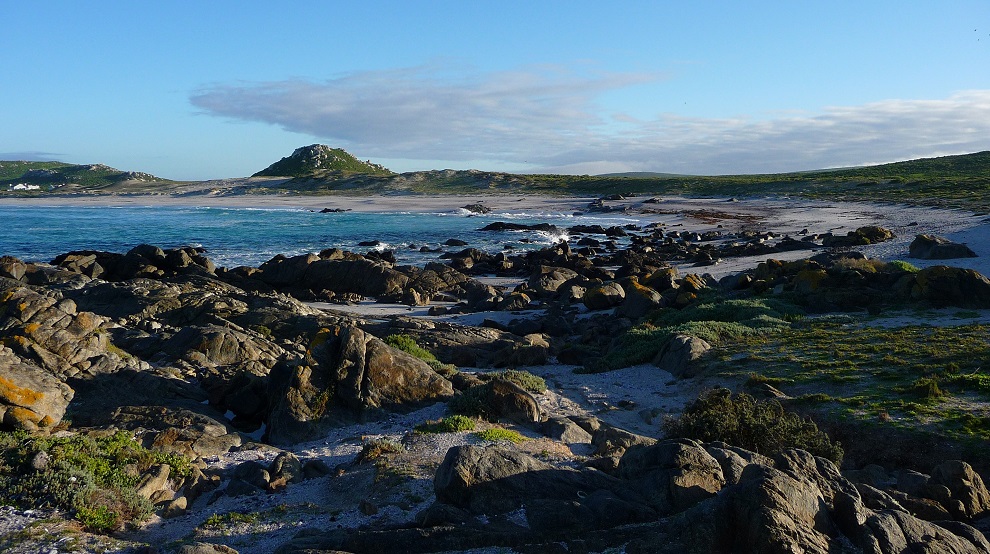
Days 5-6: Garden Route
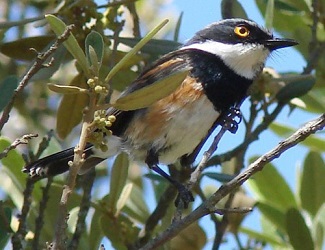 We will head east from Cape Town to the lush forested coastal region - a mosaic of coastlines, wetlands and forests -- known as the Garden Route, famous for its special species such as Knysna Turaco. Forest edge areas are the favored feeding habitat of several seedeaters, including small flocks of Swee Waxbill, Forest Canary and Cape Siskin. This is also a good place to look for foraging Black Saw-wing Swallows, and for raptors, Forest Buzzard, Black Sparrowhawk and African Goshawk. The most conspicuous birds in the forest are Sombre Bulbul, Cape Batis, and Bar-throated Apalis. Before long, however, you will intercept a bird party and thus be likely encounter Olive Woodpecker, Terrestrial Bulbul, Paradise and Blue-mantled Flycatchers, Yellow-throated Warbler, and Greater Double-collared Sunbird.
We will head east from Cape Town to the lush forested coastal region - a mosaic of coastlines, wetlands and forests -- known as the Garden Route, famous for its special species such as Knysna Turaco. Forest edge areas are the favored feeding habitat of several seedeaters, including small flocks of Swee Waxbill, Forest Canary and Cape Siskin. This is also a good place to look for foraging Black Saw-wing Swallows, and for raptors, Forest Buzzard, Black Sparrowhawk and African Goshawk. The most conspicuous birds in the forest are Sombre Bulbul, Cape Batis, and Bar-throated Apalis. Before long, however, you will intercept a bird party and thus be likely encounter Olive Woodpecker, Terrestrial Bulbul, Paradise and Blue-mantled Flycatchers, Yellow-throated Warbler, and Greater Double-collared Sunbird.
While all of these are very vocal, some, such as Terrestrial Bulbul and Olive Bush Shrike are inconspicuous lurkers, and we will likely need to invest a little patience before obtaining good views. Other species that me might encounter include the ever elusive Knysna Woodpecker, Knysna Warbler, Grey Cuckooshrike and Narina Trogon – and, of course, the showy Knysna Turaco! Wetlands offer a host of water bird species including a chance of Goliath Heron and four species of kingfisher: Pied, Giant, Malachite and Half-collared. Nights: Wilderness town.
Days 7-8: De Hoop Nature Reserve
 Today we move west toward Cape Town, for a two night stay near De Hoop Nature Reserve. Along the way, we cross large treeless plains that are the stronghold of South Africa's national bird – the Blue Crane – as well as Denham’s Bustard and Agulhas Long-billed Lark.
Today we move west toward Cape Town, for a two night stay near De Hoop Nature Reserve. Along the way, we cross large treeless plains that are the stronghold of South Africa's national bird – the Blue Crane – as well as Denham’s Bustard and Agulhas Long-billed Lark.
The main entrance gate of De Hoop Nature Reserve is located on a range of limestone hills and then the road winds down onto the lowland fynbos-swathed plains below. Covering 130 square miles, De Hoop is part of the "Cape Floral Region Protected Areas" World Heritage Site and protects the important habitat with extraordinarily high diversity and endemism associated with the unique fynbos biome.
Here, the natural shrubland or heathland of fynbos is interspersed with open pasture-like areas, relics of agriculture practices prior to the proclamation of the reserve. The open farmlands can hold Blue Crane, and Bontebok, Eland, Cape Mountain Zebra, Chacma Baboon, Angulate Tortoise, and Ostrich much favor these pastures.
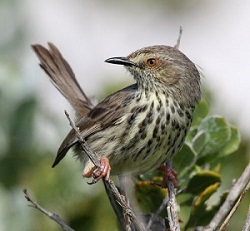 The reserve office and rest camp of De Hoop Nature Reserve are set among dense, gnarled milkwood thickets adjacent to De Hoop Vlei. This large, irregularly shaped lake can attract a huge number and an excellent diversity of waterfowl and waders, although this varies greatly between years and seasons. Recent sightings in and around the lake include Black Bustard, Kittlitz's Plover, White-fronted Plover,
The reserve office and rest camp of De Hoop Nature Reserve are set among dense, gnarled milkwood thickets adjacent to De Hoop Vlei. This large, irregularly shaped lake can attract a huge number and an excellent diversity of waterfowl and waders, although this varies greatly between years and seasons. Recent sightings in and around the lake include Black Bustard, Kittlitz's Plover, White-fronted Plover,
Long-tailed Cormorant, Western Cattle Egret, African Spoonbill,
Black-winged Kite (African), Black Harrier, Cape Grassbird, Karoo Prinia, and
Red-headed Cisticola. Southern Tchagra is shy but reasonably easy to find in the thickets around the camping area - its call is loud and conspicuous. Knysna Woodpecker also occurs, but is characteristically tricky to find and we’d be lucky to see it here. Commoner residents of the vlei-side thicket are Bar-throated Apalis, Sombre and Cape Bulbuls. The area around the Vlei and reserve buildings is also one of the best places in the southwestern Cape to see Pearl-breasted Swallow, which often feeds alongside other hirundines such as White-throated Swallow and Brown-throated Martin. Nights: De Hoop.

Photos: Cape Batis by Steve Bird; Blue Crane by Steve Hinton; Karoo Prinia by Steve Bird; Fynbos habitat by Gina Nichol.
Day 9: De Hoop to Kogelberg to Cape Town
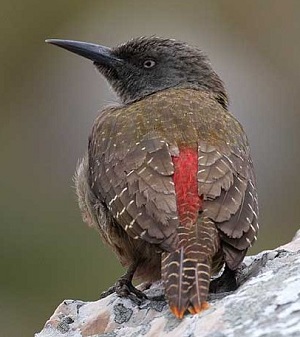 Heading still further west, we reach the Kogelberg region, where the mountains fall steeply into the sea creating a stunning landscape. The Cape Fold Mountains and the Atlantic Ocean provide a spectacular backdrop as we bird the area around the small coastal towns of Rooiels and Betty’s Bay. We’ll walk along a broad track through fynbos keeping alert for the loud piping call of the iconic Cape Rockjumper, one of the region's most charismatic and sought-after endemics. This ground-dwelling bird is a stunner with a black and white head, rufous belly, long black tail with shite tips and, in adults, a bright orange-red eye. We hope to witness a territorial display or perhaps watch "helpers" (probably related birds) assist the parents in feeding the young, a behavior that has attracted much research attention in this species.
Heading still further west, we reach the Kogelberg region, where the mountains fall steeply into the sea creating a stunning landscape. The Cape Fold Mountains and the Atlantic Ocean provide a spectacular backdrop as we bird the area around the small coastal towns of Rooiels and Betty’s Bay. We’ll walk along a broad track through fynbos keeping alert for the loud piping call of the iconic Cape Rockjumper, one of the region's most charismatic and sought-after endemics. This ground-dwelling bird is a stunner with a black and white head, rufous belly, long black tail with shite tips and, in adults, a bright orange-red eye. We hope to witness a territorial display or perhaps watch "helpers" (probably related birds) assist the parents in feeding the young, a behavior that has attracted much research attention in this species.
Birds are generally scarce in this mountain fynbos landscape, but the area does have its rewards: the series of rocky outcrops along the path and the ridges above also hold low densities of Ground Woodpecker, Familiar Chat, Cape Siskin, Cape Rock Thrush and, rarely, Sentinel Rock Thrush. Commoner birds of the dense fynbos between the ridge and the gravel track are Grassbird, Orange-breasted Sunbird, Neddicky and Karoo Prinia. Victorin's Warblers can be heard singing from the slightly denser vegetation of the hill slopes. It can be maddeningly skulking, approaching to within a meter or two but remaining well concealed in streamside thicket. Often, birds will pop up into clear view once initially, and then disappear to skulk obstinately thereafter, while tantalizingly continuing to call. Along the coast we hope to enjoy close up views of African Penguin and Cape, Bank, and Crowned Cormorants. Later on we make our way back to Cape Town for the night. Night: Cape Town.
Photo: Ground Woodpecker by Steve Hinton.
Day 10: Flight to Johannesburg and drive to Dullstroom
Today we take an early flight to Johannesburg and head toward Dullstroom, a small town about 3 hours to the northeast of the airport on our way to Kruger National park. This afternoon we will bird around Dullstroom in the highland grasslands and wetlands. These high altitude grasslands are a prime spot for Gurney’s Sugarbird and grassland endemics include Buff-streaked Chat and Yellow-breasted Pipit, which are more easily seen here than elsewhere in South Africa. Southern Bald Ibis, Denham’s Bustard and Wattled Crane will also be high on our list. Night: Dullstroom.
Day 11: Dullstroom and Blyde River Canyon
After morning birding in Dullstroom, we will drop eastwards off the escarpment towards the Kruger National Park. The second longest canyon in the world, the Blyde River Canyon, straddles the escarpment as one drops towards Kruger. Besides spectacular views, the area is excellent for raptors from Verreaux’s Eagles to Cape Vultures, and maybe even a Taita Falcon if we are lucky!
Night: Edge of Kruger.
Photo: Lilac-breasted Roller by Harry Bird.
Days 12 -15: Kruger National Park
We will spend the next four nights in the tropical lowlands of South Africa’s most famous national park, Kruger National Park. Our strategy is to explore the central and southern areas, staying at a selection of rest camps in the park in these areas. We transfer to special open sides vehicles for our time in the park, ideal for birding and mammal-watching and photography.
With more than 500 species recorded in the park, we have the chance of seeing a wide range of birds including Swainson’s Francolin, Brown-crowned and Black-crowned Tchagras, Arrow-marked Babbler, Wattled Starling, Monotonous and Sabota Larks, Emerald-spotted Wood Dove, Saddle-billed Stork, Brown-headed Parrot, Purple, European and Lilac-breasted Rollers, Southern Ground Hornbill, Orange-breasted Bush-Shrike, Burchell’s Starling, Green-winged Pytilia, Bearded Woodpecker, Burnt-necked Eremomela, African Mourning Dove, Greater Blue-eared Starling, African White-backed, White-headed and Lapped-faced Vultures, Martial Eagle, Bateluer, White-crowned Lapwing, Giant and Woodland Kingfishers and Golden-tailed Woodpecker, Terrestrial Brownbul, White-throated Robin-Chat, White-browed Robin-Chat, Yellow-fronted Tinkerbird, Striped Kingfisher, Yellow-throated Petronia, Black Cuckoo, Black-bellied Bustard, Kori Bustard, and Red-crested Korhaan.
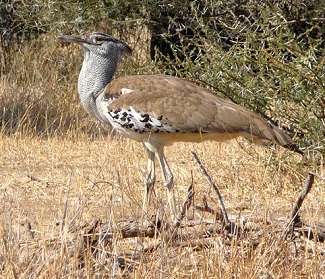 Even more species include Crested Francolin, Natal Spurfowl, Yellow-fronted Canary, Red-billed Firefinch, Blue Waxbill, Village Indigobird, Bronze Mannikin, Pin-tailed Whydah, Village, Spectacled, Lesser Masked and Southern Masked Weavers, Red-billed Buffalo Weaver, Southern Grey-headed Sparrow, Marico, White-bellied, Collared and Scarlet-chested Sunbirds, Violet-backed Starling, Red-billed Oxpecker, Cape Glossy Starling, White Helmetshrike, Mapgie and Red-backed Shrikes, Black-backed Puffback, Brubru, Chinspot Batis, African Paradise Flycatcher, Ashy Flycatcher, Tawny-flanked Prinia, Rattling Cisticola, Long-billed Crombec, Yellow-breasted Apalis, White-browed Robin-Chat, Black-headed Oriole, Southern Black Flycatcher, African Pied Wagtail, Southern Yellow-billed, Grey and Red-billed Hornbills, Green Woodhoopoe, African Hoopoe, Little, Southern Carmine, European and White-fronted Bee-eaters, Brown-hooded Kingfisher, Wire-tailed and Lesser Striped Swallow, and Grey Go-away-bird. The birding here is nothing short of fantastic!
Even more species include Crested Francolin, Natal Spurfowl, Yellow-fronted Canary, Red-billed Firefinch, Blue Waxbill, Village Indigobird, Bronze Mannikin, Pin-tailed Whydah, Village, Spectacled, Lesser Masked and Southern Masked Weavers, Red-billed Buffalo Weaver, Southern Grey-headed Sparrow, Marico, White-bellied, Collared and Scarlet-chested Sunbirds, Violet-backed Starling, Red-billed Oxpecker, Cape Glossy Starling, White Helmetshrike, Mapgie and Red-backed Shrikes, Black-backed Puffback, Brubru, Chinspot Batis, African Paradise Flycatcher, Ashy Flycatcher, Tawny-flanked Prinia, Rattling Cisticola, Long-billed Crombec, Yellow-breasted Apalis, White-browed Robin-Chat, Black-headed Oriole, Southern Black Flycatcher, African Pied Wagtail, Southern Yellow-billed, Grey and Red-billed Hornbills, Green Woodhoopoe, African Hoopoe, Little, Southern Carmine, European and White-fronted Bee-eaters, Brown-hooded Kingfisher, Wire-tailed and Lesser Striped Swallow, and Grey Go-away-bird. The birding here is nothing short of fantastic!
Mammals, of course, will be a great diversion! African Lion, Leopard, African Elephant, Water Buffalo, Burchell’s Zebra, Waterbuck, Blue Wildebeest, Impala, Steenbok, Warthog, Common Duiker and White Rhinoceros are among the possibilities. Nights: Kruger National Park. Central and Southern Rest camps (Satara, Skukuza or nearby camps).
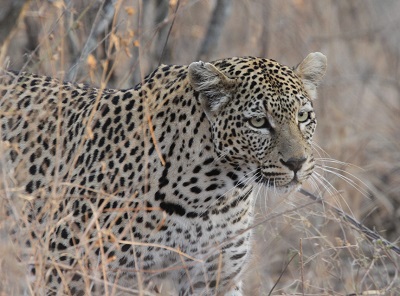
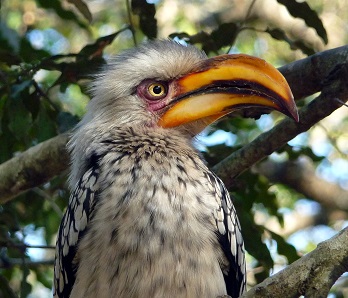
Photos: Bateluer by Harry Bird; Kori Bustard by Gina Nichol; Leopard by Harry Bird; Blue Wildebeest by Gina Nichol;
Yellow-billed Hornbill by Gina Nichol; Secretary Bird by Steve Bird; Ostrich by Gina Nichol.
Day 16: Travel day back to Johannesburg
Early breakfast and some last birding before travelling back to Johannesburg for the flights home from O.R. Tambo International Airport, Johannesburg (Airport code: JNB) in the evening.
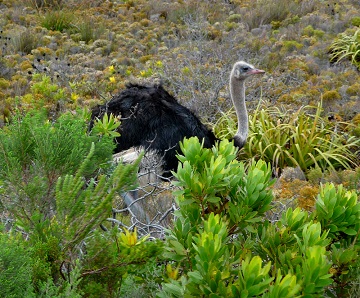 SOUTH AFRICA SOUTH AFRICAOctober 27 - November 11, 2025 Contact [email protected] to reserve your space! Registration Form> TOUR
PRICE: US$6995.00 per person, based
on
double
occupancy
and
a minimum
of
8
travelers
from
Cape Town, South Africa. Note: This tour begins in Cape Town International Airport (Airport code: CPT) and ends at O.R. Tambo International Airport, Johannesburg (Airport code: JNB) Deposit: $1000.00
per person
per tour.
Note:
Tour deposits
can be
paid by
credit
card via
PayPal.
Use this link to
make your credit card payment. Please
advise [email protected]
when you have made payment. Included in cost: All accommodations, meals, and guide services as stated in the itinerary, private ground transportation during the tour, Bottled water throughout the trip, All entrance fees for parks and nature reserves. Not included: International flights from your home to Cape Town and from Johannesburg to home, travel insurance, excess baggage charges, private excursions, à la carte dishes, tipping for drivers and guides, snacks, drinks, laundry, telephone calls and anything else of a purely personal nature. Also, any and all costs arising from illness or Covid-19 related issues are not included in the tour cost and are the sole responsibility of the traveler. These include, among others, the costs of medical treatment, hospitalization, medical fees, transport, meals and accommodation in case of illness or quarantine, and the costs of any Covid tests needed before, during and after the tour.
Once
the tour is
confirmed to
go ahead, we
will send you
information
about booking
your flights.
**Please
note: Tour prices
are based on
quoted costs
from ground operators
(in their local
currency), estimated
fuel costs, and
the rate of exchange
the time of itinerary
publication.
The erratic nature
to global financial
markets makes
it difficult
to predict changes
in costs and
foreign currency
exchange rates
over the long
term. Since tours
are priced well
in advance of
the actual operation
of the tour,
tour costs, fuel
costs and exchange
rates can change,
sometimes drastically.
Depending on
the extent of
such changes,
it may be necessary
to implement
a surcharge on
this tour. If
a surcharge is
necessary, every
effort will be
made to minimize
the amount. Cancellations
and Refunds:
TRIP INSURANCE: PLEASE NOTE:
|
Questions? Contact Gina Nichol at gina@sunrisebirding.com
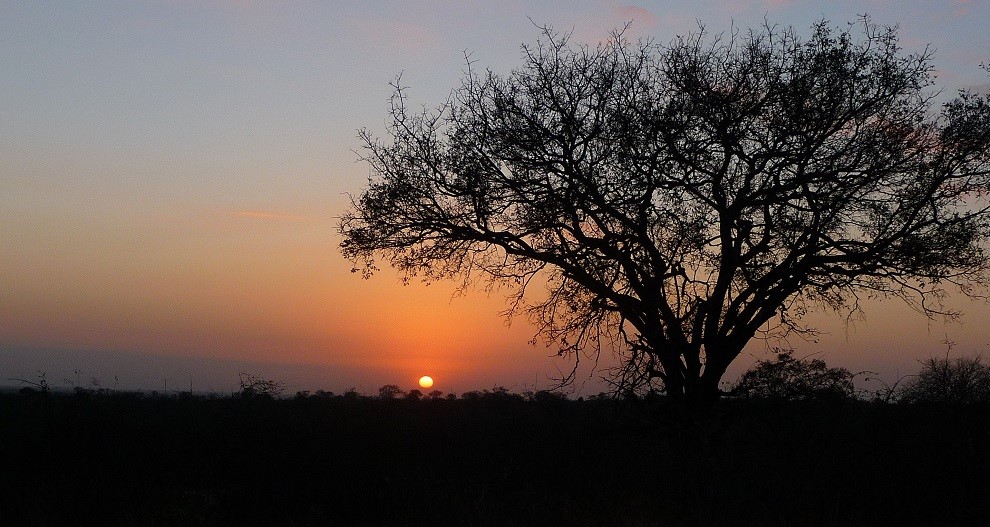
Sunrise Kruger National Park. Photo by Gina Nichol.